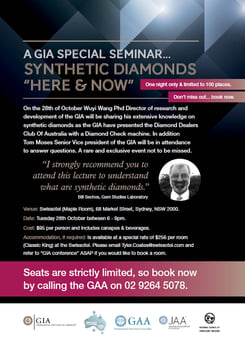 Synthetic diamonds will become a significant product in the diamond market place and will continue to do so over time. This is not a problem but an opportunity on all levels of the jewellery trade, similar to the introduction of cultured pearls and other synthetic gemstones that have come before it. So, why is there a little bit of fear in the market? Simple, it’s new, it’s difficult to detect (at this point in time, but that will change) and the industry fears its reputation may be tarnished by rogue players passing off synthetics for natural.
Synthetic diamonds will become a significant product in the diamond market place and will continue to do so over time. This is not a problem but an opportunity on all levels of the jewellery trade, similar to the introduction of cultured pearls and other synthetic gemstones that have come before it. So, why is there a little bit of fear in the market? Simple, it’s new, it’s difficult to detect (at this point in time, but that will change) and the industry fears its reputation may be tarnished by rogue players passing off synthetics for natural.
Let's be crystal clear, those who have the tendency to defraud don’t have to rely on synthetic diamonds - there are many cheaper alternatives! Because there is such a minuscule number in our trade who may act in this manner (true of all industries), we will not get caught up in a fear frenzy.
The goal here is to show that, as an industry, we do not turn a blind eye to protecting our customers both past, present and future. There is a need to understand and protect the uniqueness of buying a natural diamond and hence we act accordingly.
On my many travels and interactions as part of the World Federation of Diamond Bourses executive committee, I was fortunate enough to meet with Tom Moses, the senior vice president of the GIA. I asked if Australia could benefit from GIA’s offer to supply a Diamondcheck machine (to detect synthetic diamonds) to diamond bourses around the world. As a result of this meeting, a Diamondcheck machine has been gifted to us by the GIA... and a senior lecturer from the USA will install the machine.
After careful consideration the DDCA determined that, for Australia to benefit from such a machine, it would be of no benefit to be in our offices, but located at the offices of someone who crosses the total spectrum of the diamond and jewellery sector, has an impeccable reputation, and grades an enormous of number of loose diamonds. It was on this basis that we formally requested that the GIA allow us to have the machine installed at the offices of Bill Sechos; the GIA agreed to this.
In addition we suggested that at the time of the installation of the machine, we arrange a lecture for the Australian trade to understand what synthetic diamonds are, but we do this not as the DDCA but as an industry initiative. To this end, on the third of October we called an early morning meeting for representatives of all sectors of the industry. Those in attendance were: Nick Dracakis President GAA, Amanda Hunter Executive Director JAA, Graham Easy Executive Officer National Council of Jewellery Valuers (NSW) Bill Sechos Gem Studies Laboratory, and Cherry Shaw my Co Director at Q Report.
I put together a GIA Special Seminar as well as a promotional campaign to promote the event. At the time of writing (and having only three weeks to pull this event off) the 100 limited seats have almost been taken - with a strong possibility that we may have to increase the venue space! This is really a tremendous example of working together. Nick donated the administrative services of the GAA to organise registration, Graham worked with his team to see what point credits his members could get for attending the lecture, Amanda sending a notification to all members. From our side we organised the flyer, reached out to our membership to explain the importance of understanding what synthetics are and the impact they will have in the next few years in our industry. Last but by no means least; we secured a wonderful location at the Swissotel in Market Street Sydney to host the event.
Now the question is... how do we do more of this?
The whole education system and process of bringing on the next generation is (as was relayed to me recently in multiple conversations) under stress and in some cases under a cloud .
The future of our industry for young people is being threatened.
It’s time that all industry bodies come together and lay the problems on the table; put aside any historical issues, bring in a combination of younger participant’s and have a weekend workshop to map out where we are going and what sort of industry we want in Australia today and into the future. This lecture is a wonderful example of how - when the desire and goodwill is there - we can all work together.
Trade well.